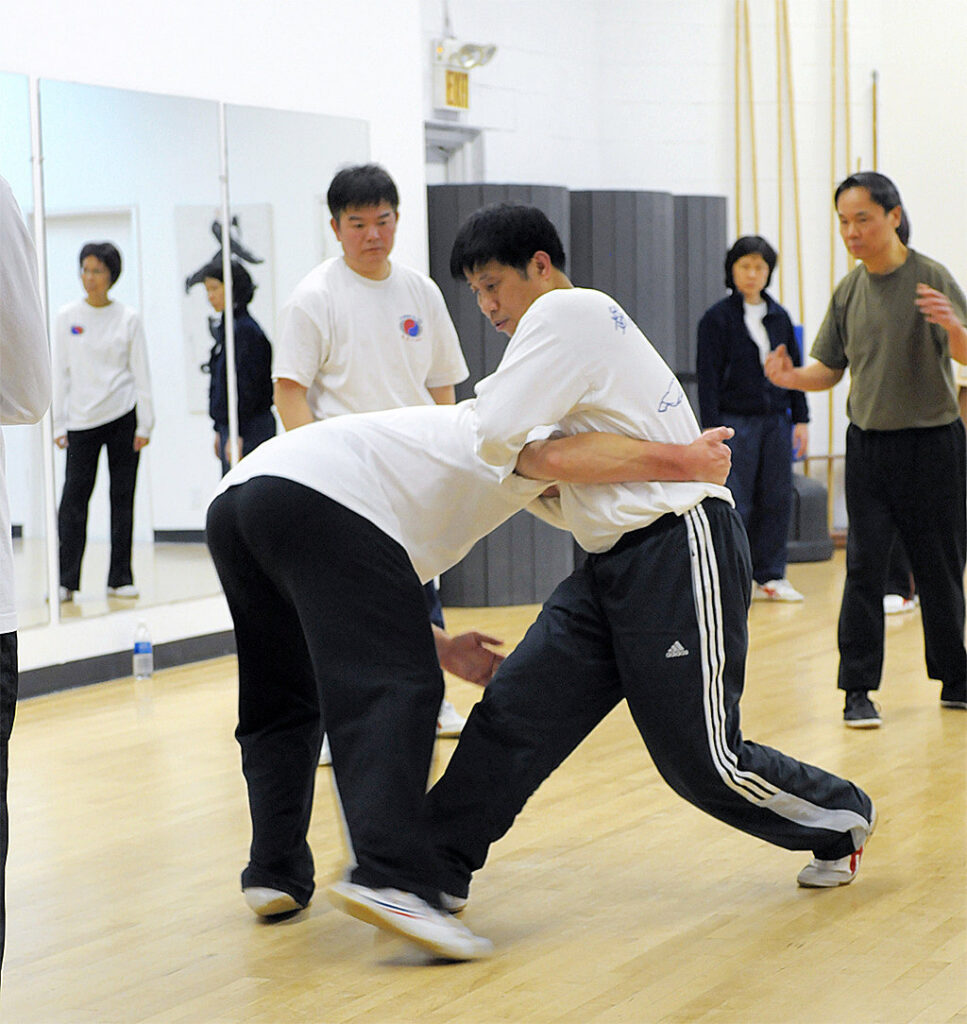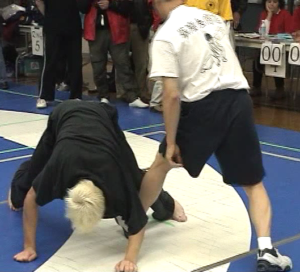Amongst the advanced tai chi classes available to improve your tai chi skills, there are weapons courses as well as push hands. Many people are lured to the novelty of using a sword or spear but push hands is a unique interactive experience not available in any of the other classes.
Many people learn and practice tai chi without ever learning push hands. It is a typical misconception that practicing push hands is only for those interested in developing martial arts skills. Thinking that if you practice tai chi for health, then you really do not need to do push hands.
In this blog, I would like to explore push hands and its importance not just for martial arts, but also for skill advancement.
What is Push Hands?
With tai chi training, we need to apply our skills to gain practical hands-on experience so we will be able to truly understand what we have learned. When we start to apply our skills, we gain valuable insights and the ability to identify weaknesses or gaps in our understanding and training.
In the martial arts world, this practical application or hands-on experience typically exists in the form of “sparring”. This practical application of skills in an interactive format shows the martial arts student how much they can apply skills in a meaningful way. With tai chi, applying skills in a practical and interactive format is equally necessary to understanding how well we are able to integrate our skills into a real or hands on situation. In tai chi, “push hands” is the practical equivalent of “sparring”.
Tai Chi push hands is a two person exercise where each person tries to unbalance the other. The techniques used to unbalance your partner cannot involve strikes or joint-locks. You also cannot touch your partner above the shoulders or below the hips. These are meant to keep push hands practice as safe as possible.
There are many different types and methods of push hands training. The various types of push hands training can be broadly categorized into 2 groups: Fixed Format and Free Format.

Fixed Format Push Hands
In fixed format push hands, partners practice push and parry patterns with each other to engage the dantian dynamically. The patterns are practiced while staying in constant contact with each other at all times.
Each partner starts by learning the movement pattern. When the partners apply the pattern together, one partner will be performing the pushing portion of the pattern while the other partner is performing the parry portion of the pattern.
These patterns are typically designed with the tai chi style in mind so there are patterns for each of Chen, Yang, and Wu styles as well as other styles of tai chi.
These patterns are also designed to help the tai chi practitioner progress slowly from simple to more complex patterns. Practice typically starts with a pattern using just one hand, then both hands, and finally both hands and feet moving together. At times, it can look like a graceful dance of two partners moving in sync.
These exercises help us to learn how to better locate and engage our dantian during movement. They also help us to learn how to sense the location of our partner’s dantian and how to maintain our own centre of balance while disarming the push of our partners force. We learn to remain standing and balanced in the face of external forces.
Pros and Cons of Fixed Format Push Hands
Cons of Fixed Format Push Hands:
- Need to learn the patterns.
- Too much emphasis placed on the pattern, forgetting the real objective is to apply tai chi principles when executing the pattern.
Pros of Fixed Format Push Hands:
- Safe environment to acquire hands-on experience.
- The element of winning versus losing is eliminated; partners can focus on getting it right.
Free Format Push Hands
With free format push hands, there is no need to learn any patterns. However, there are a plethora of other tai chi concepts and techniques to learn and apply. Free format push hands practice most closely resembles what other martial arts recognize as “sparring”. The objective in this practice is to remain balanced at all times while attempting to throw the other person off balance.
For safety, all sparring engagements have rules that both partners must follow. The two most common rules pertaining to tai chi push hands are: Fixed Step and Moving Step.
Fixed Step Push Hands
With Fixed Step Push Hands, both partners plant their feet and cannot move them. At least one part of the foot must remain planted on the floor at all times. Even shuffling of the feet is not allowed. No other body part may touch the floor.
The Fixed Step push hands practice is popular because it can achieve the goals of free format push hands without the use of mats. The likelihood of someone actually falling to the floor is very low. The amount of force required to make someone move a foot is also relatively low.
Yet, the core principles of push hands can be practiced and achieved through the Fixed Step push hands practice.
Moving Step Push Hands
With Moving Step Push Hands, boundaries must be set so the partners do not go out of bounds. Within the boundaries, only the feet can touch the floor. Any other body part touching the floor is considered a loss. Going out of bounds is also considered a loss.
This Moving Step push hands practice is the closest to real life hands-on application. It requires good stamina and power to engage your partner for as little as 5 minutes. With Moving Step push hands practice, you will need to learn a few take down techniques. Otherwise, the other option is to push your partner out of bounds.
Pros and Cons of Free Format Push Hands
Cons of Free Format Push Hands:
- Creates a competitive environment with someone losing / winning.
- Risk of injury is higher when someone loses balance and falls.
Pros of Free Format Push Hands:
- No need to learn patterns.
- Mistakes or principles not correctly applied are exposed immediately. Failure is our best teacher.
The Importance of Push Hands in Tai Chi Training
With tai chi forms practice, we incorporate the tai chi principles of movement into our body. We apply it and demonstrate it through the wide variety of movements performed in the form. This helps us to understand and learn the principles of movement and balance well.
What we can learn from practicing tai chi forms is limited. When performing a form, there is no external interference or unexpected situations. All the movements are pre-determined. It is easier to prepare and practice the form until moving the way that you were taught becomes a muscle memory.
Knowing how to perform the sequence of movements required by a form is not necessarily the same as mastering the movement concepts. Once you have practiced tai chi with us for a while, you know that tai chi is more than memorizing and being able to carry out the movements. Tai chi is also about mastering the concepts of movement and balance.
To have these movement techniques ingrained in the practitioner so that they are both instinctive and natural, interactive training practice is a necessity. Advanced practice techniques such as push hands is an essential component of training the body to constantly apply the concepts of movement and balance in the face of real world and unexpected external forces.
Complementing Tai Chi Forms with Push Hands
Since Push Hands is an interactive form of tai chi training practiced with a partner this makes push hands practice quite different from forms practice. The main difference is the presence of an external force acting on the practitioner’s movements and balance.
In the free format push hands, there is the added element of unpredictability. As an advanced form of training, push hands puts us to the test of finding out if we have learned our lessons well. We test to see if we have learned what it takes to remain balanced over our feet even when someone else is aiming to unbalance us.
When forced to react instinctively, we will be exposed to any inadequacies in our training and our understanding of balance and movement. With this understanding, we can return to forms practice with renewed focus to improving on these skills.
Push hands training and tai chi forms practice go hand in hand. Using this combination of practice allows us to progress at the most optimal pace in our learning. One type of tai chi practice is not better than the other type. In fact, forms based tai chi practice and push hands are the ideal complements in learning tai chi.







[…] he climbed the ranks of Tai Chi Chuan Push Hands (here you go), he became good enough to participate in national championships. That meant travelling, and one […]